以基因组为中心的亚转录组学揭示了科莫司硝基螺旋菌在弱酸性条件下的长期稳定性及其酸适应机制。
IF 9.7
1区 环境科学与生态学
Q1 AGRICULTURAL ENGINEERING
引用次数: 0
摘要
尽管它们在酸性环境中广泛存在,但完全氨氧化(comammox)细菌的稳定性和适应机制仍然知之甚少。在这项为期三年的研究中,通过宏基因组和基于cdna的16S rRNA测序显示,在酸性硝化反应器(pH = 6.3-6.8)中,comammox Nitrospira的丰度和活性一直占据主导地位。批量试验表明,它们的硝化作用良好,可达pH值4.7,而在pH值4.2时停止。以基因组为中心的超转录组学研究显示,在酸性条件下,comammox Nitrospira上调了rh型铵转运蛋白,以增强底物的吸收。由NADH脱氢酶和f型atp酶介导的主动质子转运被确定为维持comammox Nitrospira pH稳态的主要策略。与碳获取、趋化性和DNA修复相关的基因在低pH下上调,表明这些过程在酸适应中发挥作用。这些发现增强了对酸性环境中comammox菌的生态作用和适应机制的认识。本文章由计算机程序翻译,如有差异,请以英文原文为准。

Long-term stability of comammox Nitrospira under weakly acidic conditions and their acid-adaptive mechanisms revealed by genome-centric metatranscriptomics
Despite their widespread presence in acidic environments, the stability and adaptative mechanisms of complete ammonia oxidization (comammox) bacteria remain poorly understood. In this three-year study, comammox Nitrospira consistently dominated both abundance and activity in an acidic nitrifying reactor (pH = 6.3–6.8), as revealed by metagenomic and cDNA-based 16S rRNA sequencing. Batch tests demonstrated their decent nitrification down to pH 4.7, while ceasing at pH 4.2. Genome-centric metatranscriptomics revealed that comammox Nitrospira upregulated a Rh-type ammonium transporter to enhance substrate uptake under acidic conditions. Active proton transport, mediated by NADH dehydrogenases and F-type ATPase, was identified as a primary strategy for maintaining pH homeostasis in comammox Nitrospira. Genes associated with carbon acquisition, chemotaxis, and DNA repair were upregulated at low pH, suggesting these processes play roles in acid adaptation. These findings enhance the understanding of ecological roles and adaptive mechanisms of comammox bacteria in acidic environments.
求助全文
通过发布文献求助,成功后即可免费获取论文全文。
去求助
来源期刊

Bioresource Technology
工程技术-能源与燃料
CiteScore
20.80
自引率
19.30%
发文量
2013
审稿时长
12 days
期刊介绍:
Bioresource Technology publishes original articles, review articles, case studies, and short communications covering the fundamentals, applications, and management of bioresource technology. The journal seeks to advance and disseminate knowledge across various areas related to biomass, biological waste treatment, bioenergy, biotransformations, bioresource systems analysis, and associated conversion or production technologies.
Topics include:
• Biofuels: liquid and gaseous biofuels production, modeling and economics
• Bioprocesses and bioproducts: biocatalysis and fermentations
• Biomass and feedstocks utilization: bioconversion of agro-industrial residues
• Environmental protection: biological waste treatment
• Thermochemical conversion of biomass: combustion, pyrolysis, gasification, catalysis.
 求助内容:
求助内容: 应助结果提醒方式:
应助结果提醒方式:


